Exploring Ecology
In these activities, learners explore the connections between local animals and their habitats. Key concepts include: survival needs, adaptations, food chains, interrelationships.
The learning intentions for each activity can be modified to suit the year levels indicated
- Web of Life Game (Years R - 9)
- Freshwater Life (Years R - 12)
- Looking for Evidence (Years R - 6)
- Life under Leaves (Years R - 2)
- Natures Recyclers (Years 3 - 9)
- Plant Propagation (Years 3 - 12)
- Animal Survival (Years 3 - 6)
- Bird Ecology (Years 4 - 9)
- Catchment Walk (Years 4 - 12)
- Hidden World (Years 4 - 9)
 Learners play the roles of predator and prey species in a simulation game. To survive, they must locate ‘food’ and ‘water’ hidden in an open woodland area. They learn about animal behaviour and survival strategies.
Learners play the roles of predator and prey species in a simulation game. To survive, they must locate ‘food’ and ‘water’ hidden in an open woodland area. They learn about animal behaviour and survival strategies.
Examples of Australian Curriculum Links
Science
Year 1 AC9S1U01
Year 4 AC9S4U01
Year 5 AC9S5U01
Year 6 AC9S6U01
Year 7 AC9S7U02
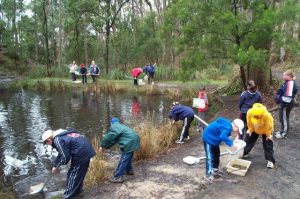 Learners collect samples of invertebrates using nets and observe them using magnifiers, microscopes and a video camera. They can explore feeding relationships, adaptations for survival, lifecycles and habitat requirements of freshwater life.
Learners collect samples of invertebrates using nets and observe them using magnifiers, microscopes and a video camera. They can explore feeding relationships, adaptations for survival, lifecycles and habitat requirements of freshwater life.
Examples of Australian Curriculum Links
Science
Foundation AC9SFU01
Year 1 AC9S1U01
Year 3 AC9S3U01
Year 4 AC9S4U01
Year 5 AC9S5U01
Year 7 AC9S7U02
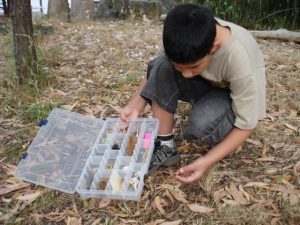 Learners become ‘bush detectives’ by searching for evidence of animal life in the stringybark forest. Many animals are hard to see due to their behaviour or appearance, but curious detectives can find evidence of them by careful observation.
Learners become ‘bush detectives’ by searching for evidence of animal life in the stringybark forest. Many animals are hard to see due to their behaviour or appearance, but curious detectives can find evidence of them by careful observation.
Examples of Australian Curriculum Links
Science
Year 1 AC9S1U01
Year 1 AC9S1H01
Year 2 AC9S2H01
Year 5 AC9S5H02
 Learners search for leaf-litter invertebrates and fungi then observe them using magnifiers. They learn that nature’s recyclers release nutrients from dead plant and animal material and return them to the soil.
Learners search for leaf-litter invertebrates and fungi then observe them using magnifiers. They learn that nature’s recyclers release nutrients from dead plant and animal material and return them to the soil.
Examples of Australian Curriculum Links
Science
Year 4 AC9S4U01
Year 5 AC9S5U01
Year 6 AC9S6U01
Year 7 AC9S7U02
In the school’s plant nursery, learners follow basic nursery procedure to propagate local species from seed. This follows an exploration of flowering plant reproduction and diversity, including flowers, seeds, seed “containers”, and survival features of local plant groups.

Examples of Australian Curriculum Links
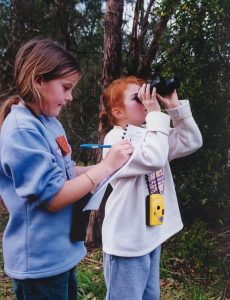 Learners practise the skills of bird watching and identification. They observe bird behaviour and learn about how different species fit into the ecology of different habitats. A collection of bird specimens allows close examination.
Learners practise the skills of bird watching and identification. They observe bird behaviour and learn about how different species fit into the ecology of different habitats. A collection of bird specimens allows close examination.
Examples of Australian Curriculum Links
With the aid of maps and a 3D model, learners walk through the school property to experience the features of a catchment. They explore how land use affects drainage and water quality and compare this to their local catchment.
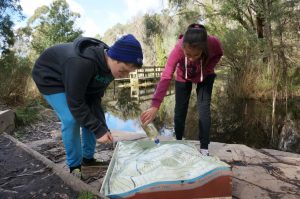 Examples of Australian Curriculum Links
Examples of Australian Curriculum Links
Science
Year 4 AC9S4U02
Geography
Year 4 AC9HS4K05
Year 7 AC9HG7K01


 Learners learn about animal adaptations, investigating specimens in our Ecocentre, and observing animals to connect features to particular uses.
Learners learn about animal adaptations, investigating specimens in our Ecocentre, and observing animals to connect features to particular uses.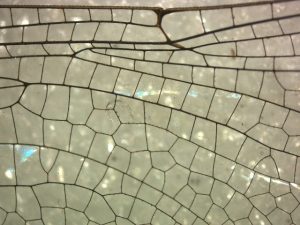 Learners explore a ‘hidden world’, so small that is normally invisible to the naked eye. They collect samples from the local environment to investigate under microscopes.
Learners explore a ‘hidden world’, so small that is normally invisible to the naked eye. They collect samples from the local environment to investigate under microscopes.




